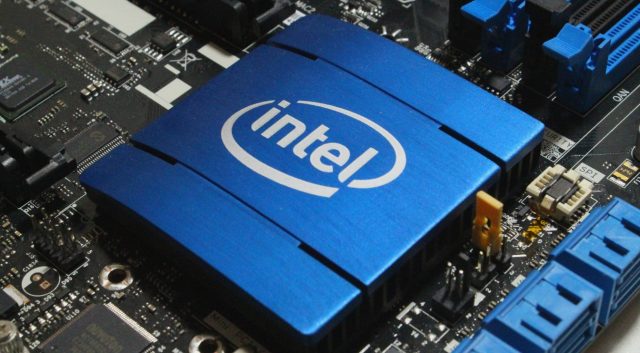Intel Launches New 18-Core Core i9-9980XE CPU
Intel has launched its new line-up of Core X microprocessors at substantially higher clock speeds compared with the chips it launched a year ago. At the top of the stack, there’s the new Core i9-9980XE with a base clock of 3GHz and a boost clock of 4.4GHz (4.5GHz if Intel’s Turbo Boost Max 3.0 is enabled). That’s a substantial jump from the Core i9-7980XE, the chip Intel launched in Q3 2017, which came in at 2.6GHz base, 4.2GHz max and 4.4GHz with TB 3.0 enabled. Below that point, the new chips generally feature larger caches, higher base frequencies, and more PCIe lanes (in one case).
Here’s the entire product stack comparing Intel’s new 9th generation Core X CPUs![]() , the 7xxx parts they replace, and the relative competitive standing of AMD’s Threadripper, all organized by price.
, the 7xxx parts they replace, and the relative competitive standing of AMD’s Threadripper, all organized by price.
The improvements vary depending on the CPU you compare, but we can see clear trends. Every CPU’s base clock comes up, in some cases by significant margins. The number of cores Intel is willing to sell at a given price point hasn’t changed at all — while some of the new model numbers carry more cores than the chips they replace, they all sell for higher prices.
If you wanted proof that Intel is manifestly unconcerned about Threadripper, well, this is it right here. Intel might be offering higher frequency chips for the same amount of money with more L3 cache and PCIe lanes in some cases, but it isn’t budging on its pricing stack. Intel has changed which Xeon silicon it’s using for some of its HEDT parts, however, which is why you see the sharp L3 cache increases on multiple parts. Intel has also gone back to using solder for its HEDT chips after using paste on the stack last year, which probably also explains some of the frequency improvements, along with the shift to using 14nm++ for these CPUs rather than its older 14nm process. All parts now also offer 44 PCIe lanes, whereas previous CPUs used a mixture of 44 PCIe lanes at the top end and 28 PCIe lanes farther down the stack.
Intel claims that its 14nm++ process offers an overall 15 percent efficiency gain, though of course that’s an idealized best-case figure not necessarily applicable to every workload. Tech Report notes that the Turbo Mode settings for the Core i9-9980XE are significantly higher than the 7980XE, however, with the 9980XE holding an all-core boost frequency of 3.8GHz without AVX compared with 3.4GHz for the 7980XE.
How’s Performance?
I’ve read reviews from Anandtech, Tech Report, Hot Hardware, and Tom’s Hardware. The results play out as a near-mirror of the Core i9-9900K. While Intel is the unabashed overall performance leader and is generally recognized as such, AMD has stuck a Threadripper-sized rock down the company’s windpipe. We can’t deny that Intel appears blissfully unconcerned about this — the company is sticking to its guns as far as pricing is concerned and that doubtlessly reflects certain market realities that AMD fans might wish weren’t true. In the long-term — and I say this as someone who watched AMD’s original ramp from the K6-2 in 1998 to the Athlon 64 X2 — they won’t hold true. Workstation and enterprise companies are conservative, not stupid, and if AMD keeps improving year-on-year you’ll eventually start seeing more workstations built on AMD chips. AMD also keeps ECC as a feature for Threadripper, Intel deactivates it to defend its Xeon stack.
Tech Report has a slide that captures the situation fairly well:

Image by Tech Report
Obviously, any single chart won’t give you a breakdown of test-by-test results. Anandtech notes that in benchmarks where AMD can bring its full weight to bear, like dedicated rendering tests, AMD![]() often leads the category. The bottom line, however, is that the Core i9-9980XE improves performance between 3-7 percent on average over the Core i9-7980XE. In the same way that the Core i9-9900K is faster than the Ryzen 7 2700X but not necessarily in a manner that justifies its price, the Core i9-9980XE leads the Threadripper 2950X without necessarily justifying its price. Tom’s Hardware certainly doesn’t think it does; the site’s review title is a straightforward: “Intel Core i9-9980XE Review: Still Too Expensive.”
often leads the category. The bottom line, however, is that the Core i9-9980XE improves performance between 3-7 percent on average over the Core i9-7980XE. In the same way that the Core i9-9900K is faster than the Ryzen 7 2700X but not necessarily in a manner that justifies its price, the Core i9-9980XE leads the Threadripper 2950X without necessarily justifying its price. Tom’s Hardware certainly doesn’t think it does; the site’s review title is a straightforward: “Intel Core i9-9980XE Review: Still Too Expensive.”
More generally, reviewers aren’t satisfied with Intel’s efforts to mark time. It’s a sentiment I share. It’s also a consequence of the fact that Intel has spent years trying to fix its 10nm process, continually shoving off architectural changes and product launches in an effort to bring order to the largest derailment of its manufacturing plans in the past 20 years. It’s not surprising that people feel as if most of the energy in the proverbial room is coming from AMD’s side of the equation. As things stand, the Core i9-9980XE feels like yet another modest iteration on a product rather than a true step forward.
Culled from Extreme Tech




